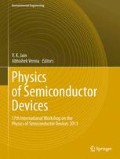Abstract
We report synthesis, characterization and use of ternary zinc complex as emissive and electron transport material in organic light emitting devices (OLED). 5,7-dimethyl-8-hydroxyquinoline have been used with 2-(2-hydroxyphenyl) benzoxazole to synthesize (2-(2-hydroxyphenyl)benzoxazolato) (5,7-dimethyl-8-hydroxyquinolinato)zinc(II) [Zn(HPB)(Me2q)]. The complex possessed high thermal stability and having good film forming property. Optical properties of the synthesized complex have been studied by UV–visible absorption, photo-luminescence and transient photo-luminescence spectroscopy. Synthesized material shows quite good efficiency in multilayered device structure ITO/α-NPD/Zn(HPB)(Me2q)/BCP/Alq3/LiF/Al with maximum brightness of 4017 cd/m2 having electroluminescence spectral peak emission centered at 567 nm. Electron mobility of the synthesized complex was found to be 1.5 × 10−6 − 1.2 × 10−5 cm2/V s. for electric field range 1,000–1,200 (V/cm)1/2 and hence can be used as electron transport material in OLEDs.
Access this chapter
Tax calculation will be finalised at checkout
Purchases are for personal use only
References
Y.P. Jeon, D.C. Choo and T.W. Kim, Thin Solid Films, 521, 189 (2012).
K.Y. Hwang, H. Kim, Y.S. Lee, M.H. Lee and Y.K. Do, Chem. Eur. J.,15, 6478 (2009).
W.A.E. Omar, H. Haverinen and O.E.O. Hormi, Tetrahedron, 65 9707 (2009)
N. Du, Q. Mei and M. Lu, Synth. Metals, 149, 193 (2005).
N. Donze, P. Pechy, M. Gratzel, M. Schaer and L. Zuppiroli, Chem. Phys. Lett., 315, 405 (1999).
A. Yeh and T.R. Chen, Mater. Lett., 59, 2911 (2005).
H.P. Zeng, G.R. Wang, G.C. Zeng and J. Li, Dyes and Pigments, 83, 155 (2009).
A. Kumar, R. Srivastava, A. Kuma, V. Nishal, P. S. Kadyan, M.N. Kamalasanan and I. Singh, Journal of Organometallic Chemistry, 740, 116 (2013).
Author information
Authors and Affiliations
Corresponding author
Editor information
Editors and Affiliations
Rights and permissions
Copyright information
© 2014 Springer International Publishing Switzerland
About this paper
Cite this paper
Kumar, A. et al. (2014). Mixed Ligand Orange Emitter Zinc Complex for Organic Light Emitting Diodes. In: Jain, V., Verma, A. (eds) Physics of Semiconductor Devices. Environmental Science and Engineering(). Springer, Cham. https://doi.org/10.1007/978-3-319-03002-9_229
Download citation
DOI: https://doi.org/10.1007/978-3-319-03002-9_229
Publisher Name: Springer, Cham
Print ISBN: 978-3-319-03001-2
Online ISBN: 978-3-319-03002-9
eBook Packages: Earth and Environmental ScienceEarth and Environmental Science (R0)

